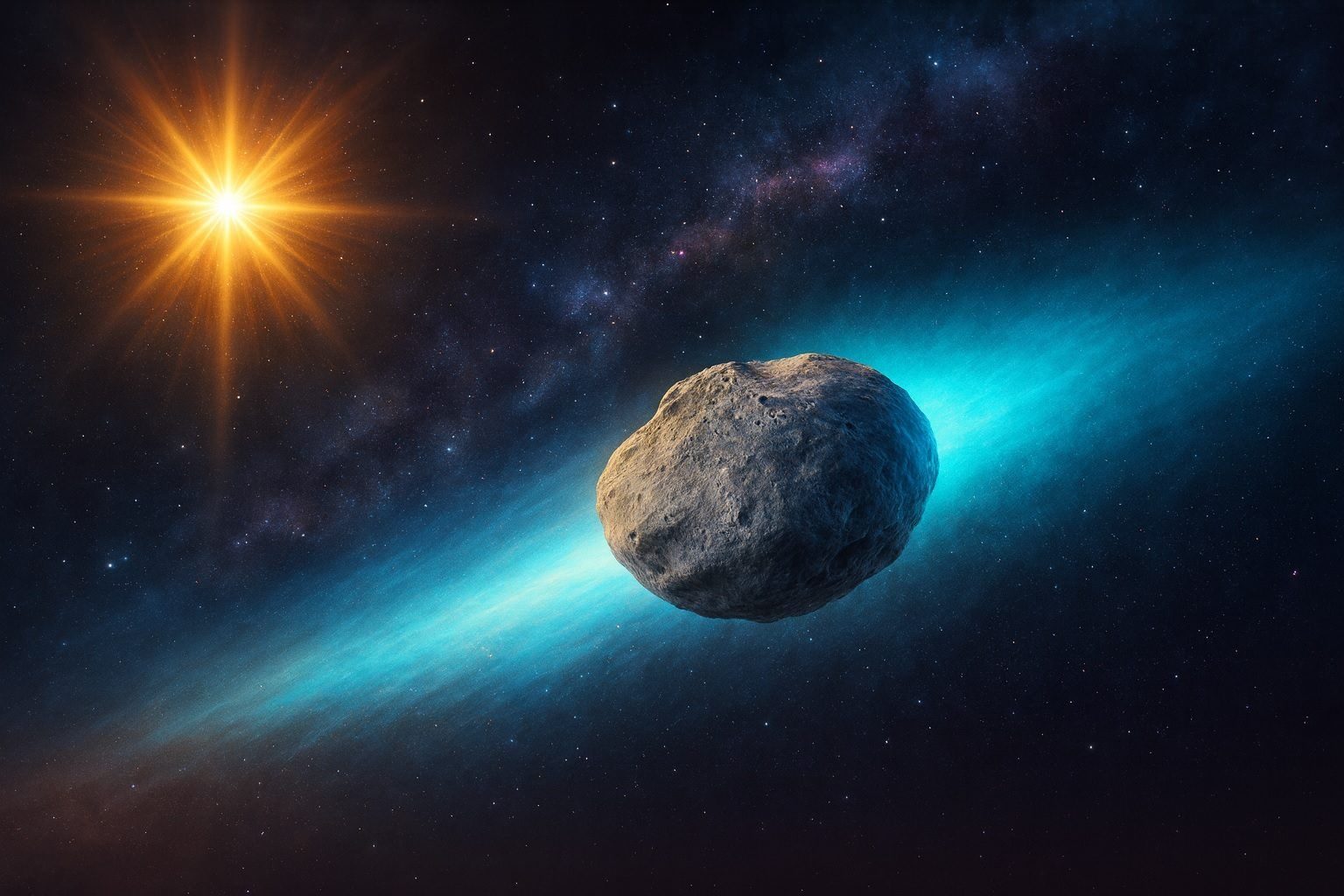Published: November 25, 2025
As the interstellar comet 3I/ATLAS speeds out of the inner solar system, the story around it is accelerating just as fast.
In the last few days NASA has released a flood of new images and animations, the United Nations has confirmed that 3I/ATLAS is at the center of a global planetary‑defense drill, and a high‑profile podcast has reignited debate over whether this icy visitor could be “something alien.” [1]
Here’s what we actually know today about 3I/ATLAS — and what’s speculation.
What is Comet 3I/ATLAS?
3I/ATLAS (also catalogued as C/2025 N1 ATLAS) is only the third known interstellar object ever seen passing through our solar system, after 1I/ʻOumuamua (2017) and 2I/Borisov (2019). [2]
Key facts:
- Origin: Its path is unmistakably hyperbolic — an open, one‑time fly‑through orbit that can’t be bound to the Sun — which is why astronomers classify it as interstellar. [3]
- Discovery: It was first reported on July 1, 2025, by the NASA‑funded ATLAS survey telescope in Rio Hurtado, Chile. Pre‑discovery images show it had already been active months earlier. [4]
- Path through the solar system: 3I/ATLAS swung closest to the Sun on October 29, 2025, at about 1.36 astronomical units (AU) — a bit inside Mars’ orbit — and will never return. [5]
- Safety: It will pass no closer than roughly 170 million miles (≈1.8 AU) from Earth in mid‑December, far too distant to pose any threat. [6]
Observations suggest the nucleus is at most a few kilometers wide and is probably older than our 4.6‑billion‑year‑old solar system, with some studies putting its age around 7–8 billion years. [7]
NASA’s solar‑system‑wide photo shoot
Twelve NASA assets, one interstellar comet
NASA has turned 3I/ATLAS into a truly solar‑system‑wide observing campaign. According to a November 19 NASA feature, twelve NASA missions have now imaged or measured the comet, from Mars orbit to deep‑space asteroid probes. [8]
That fleet includes:
- At Mars:
- Mars Reconnaissance Orbiter (MRO) and its HiRISE camera captured some of the closest views on October 2, when the comet was about 19 million miles from Mars. [9]
- MAVEN used its ultraviolet spectrograph to map a glowing coma of hydrogen and other gases, helping pin down the comet’s composition. [10]
- The Perseverance rover grabbed an extremely faint streak from Jezero Crater on October 4 — a comet image taken from the surface of another planet. [11]
- Sun‑watching missions:
- STEREO‑A tracked 3I/ATLAS between September 11–25 with its HI1 camera, stacking many frames to pull a fuzzy orb out of the noisy background. [12]
- ESA/NASA’s SOHO caught the comet as a barely brighter smudge near the Sun from October 15–26. [13]
- The new PUNCH mission watched the comet’s short tail as it swept through space from September 20 to October 3. [14]
- Asteroid explorers:
- Big space telescopes and surveyors:
- The Hubble Space Telescope revealed a teardrop‑shaped blue dust cloud around the nucleus back in July. [17]
- The James Webb Space Telescope (JWST) and SPHEREx measured the comet’s infrared glow in August, uncovering a wildly CO₂‑rich coma (more on that below). [18]
- The ATLAS telescopes continue to track its changing brightness and trajectory. [19]
A new NASA image gallery pulls many of these views into one place, spanning first discovery on July 1 through today’s outbound phase. [20]
New public animation launched today
Adding to the visual feast, an article published today highlights a new 3D animation from NASA’s Jet Propulsion Laboratory, built with the agency’s “Eyes on the Solar System” tool. The visualization traces 3I/ATLAS from late 2023 through 2028, showing its sweeping hyperbolic arc past the Sun and out toward Jupiter’s orbit. [21]
The animation uses four different viewing angles to show:
- how the comet dives in from the direction of the Milky Way’s center,
- how its path is deflected by the Sun’s gravity, and
- how its track threads through the orbits of Mars, Jupiter and NASA’s spacecraft.
It’s designed both as outreach and as a teaching tool, helping non‑specialists visualize why interstellar objects move differently from home‑grown comets.
Yahoo’s photo roundup for general audiences
Within the last day, Yahoo News has turned NASA’s technical releases into an accessible photo gallery, packaging 12 key images — including Psyche’s eight‑hour observing sequence — into a swipeable slideshow that emphasizes how many independent spacecraft are all watching the same icy visitor. [22]
For many readers, that gallery is the easiest single place to see the comet through “NASA’s multiple lenses” without diving into mission‑by‑mission technical pages.
A UN‑backed planetary‑defense drill – and what it means
One of today’s most important developments is not a new picture, but a policy document.
A blog post published this morning by The Times of Israel reproduces, in full, an official United Nations / International Asteroid Warning Network (IAWN) document describing a “3I/ATLAS Comet Astrometry Campaign.” [23]
Key points from that UN/IAWN text:
- 3I/ATLAS “poses no threat” and was specifically chosen because it’s safe but scientifically interesting.
- The campaign is labeled the 8th IAWN observing exercise since 2017, meant to practice precise position measurements of a fuzzy, active comet — more challenging than tracking point‑like asteroids.
- The timeline includes:
- Registration deadline: November 7, 2025
- Workshop: November 10
- Kick‑off email: November 25 (today)
- Observing window: November 27, 2025 – January 27, 2026
- Close‑out telecon: February 3, 2026 [24]
By centering a formal, global observing drill on 3I/ATLAS, UN‑affiliated agencies are signaling two things at once:
- The comet is scientifically valuable but harmless, and
- It’s an ideal test case for improving the techniques we’d need if a future comet or asteroid ever did pose a risk.
Is 3I/ATLAS an “alien spacecraft”? What NASA actually said
Speculation about 3I/ATLAS being artificial has surged across social media, echoing the debates around ʻOumuamua. That conversation hit mainstream again yesterday via The Big Story, a Canadian podcast from CityNews, in an episode titled “A cosmic rock or an alien threat?” featuring Harvard astrophysicist Avi Loeb. [25]
Loeb has argued in recent essays that some features of 3I/ATLAS — including its non‑gravitational acceleration and its extremely close future pass to Jupiter’s “Hill sphere” of gravitational influence — are suspiciously precise and might be consistent with a guided spacecraft or “mothership.” [26]
However, NASA’s position is unambiguous.
At a November 19 press conference held at Goddard Space Flight Center, agency leaders repeatedly stressed that:
- 3I/ATLAS looks and behaves exactly like a comet, with a normal coma and dust tail.
- No “technosignatures” (signals or behaviors indicating technology) have been detected.
- The object’s brightness variations and outgassing are consistent with ices sublimating as it nears the Sun. [27]
In a detailed Reuters report on that briefing, NASA officials and independent astronomers emphasize that the comet’s composition — rich in carbon dioxide, with water, carbon monoxide, cyanide and nickel — sits comfortably within (if on the extreme end of) what has been seen in other comets, including 2I/Borisov. [28]
Oxford astrophysicist Chris Lintott is quoted as dismissing the alien‑craft idea as “nonsense,” noting there is “nothing about it that suggests such a thing” once the data are viewed in context. [29]
So while speculation makes headlines and podcasts, the evidence available today supports a natural — if unusual — comet.
The wild chemistry of an interstellar comet
Even if it’s “just” a comet, 3I/ATLAS is weird in important scientific ways.
An extreme CO₂ comet
JWST and ground‑based telescopes have shown that 3I/ATLAS’s coma is dominated by carbon dioxide gas, with far less water vapor than in most solar‑system comets. One analysis found a CO₂‑to‑water ratio of roughly 8:1, one of the highest ever measured. [30]
That suggests:
- It may have formed in an ultra‑cold region where CO₂ ice is abundant and water stays locked away, or
- Its surface may have developed an insulating crust that suppresses water vapor while CO₂ escapes.
A crust reshaped by billions of years in deep space
A recent study using JWST data, reported earlier this month, argues that billions of years of exposure to galactic cosmic rays have transformed the comet’s outer layers. High‑energy radiation appears to have converted much of the outer carbon monoxide into CO₂, forming a crust perhaps 15–20 meters thick. [31]
That would mean:
- The material we see venting now may not reflect the comet’s original makeup when it left its home system.
- Ongoing erosion as it swings past the Sun could eventually expose fresher “interior” ice — a tantalizing target for continued observations in 2026.
Nickel, cyanide and subtle “anomalies”
Spectroscopy from ESO’s Very Large Telescope (and follow‑up analysis highlighted by Avi Loeb) reveals unusually strong nickel emission, detected even before cyanide — the reverse of what’s typically seen. Over July–August, both nickel and CN production rates increased as the comet approached the Sun. [32]
While that has been framed by some as an “anomaly,” comet specialists point out that:
- Interstellar comets are expected to show chemical oddities, because they formed in different stellar nurseries.
- Nickel and cyanide are also seen in many ordinary comets; it’s the precise ratios and timing that are unusual, not their presence.
For now, the consensus view is that 3I/ATLAS is an extreme natural outlier, not evidence of technology.
How and when to see 3I/ATLAS yourself
Even with all the hype, don’t expect a blazing spectacle overhead. 3I/ATLAS remains a faint telescope object, not a naked‑eye comet.
According to EarthSky and amateur reports:
- Around late November and early December, the comet is climbing into the eastern pre‑dawn sky, emerging from behind the Sun as seen from Earth. [33]
- It is hovering near the constellations Virgo and then Leo, appearing as a fuzzy “star” of roughly magnitude 10–11 — within reach of medium‑sized backyard telescopes under dark skies. [34]
- ESA’s JUICE spacecraft has been observing it between November 2 and 25, likely catching it near maximum activity with multiple jets. [35]
For interactive views, NASA recommends its Eyes on the Solar System web tool, which now includes a dedicated 3I/ATLAS mode tied to the same trajectory used in JPL’s new animation. [36]
If you want to try observing it:
- Use a computerized or plate‑solving telescope that can reach magnitude ~11.
- Consult up‑to‑date finder charts from reliable astronomy outlets.
- Look just before dawn, low in the east, and expect a faint smudge rather than a dramatic tail.
Why 3I/ATLAS matters
Beyond today’s headlines, 3I/ATLAS is reshaping how scientists think about both planetary defense and interstellar planet formation.
- A rare sample of another solar system
Its chemistry and age suggest it may have formed in a very different environment — possibly in a colder, more CO₂‑rich region of the Milky Way — giving astronomers a real, physical fragment of another system to study. [37] - A live exercise in global coordination
The UN/IAWN campaign uses 3I/ATLAS as a testbed for tracking challenging objects and sharing data worldwide. The fact that this is the eighth such exercise underlines how seriously agencies are taking future impact risks — even when the current object is benign. [38] - A preview of the Vera Rubin era
With next‑generation surveys coming online later this decade, astronomers expect many more interstellar visitors. 3I/ATLAS is a dress rehearsal for how fast the community — and the public — reacts when the next one appears. - A case study in science vs. hype
The contrast between careful, multiwavelength observations and viral alien theories is stark. NASA and UN documents are explicit that 3I/ATLAS is a comet and a training opportunity, not a threat. The coming months will be an important lesson in how well evidence can compete with speculation in the age of online rumor.
For now, though, the story is simple:
A small, ancient ice‑rock from another star system is racing past our Sun, scientists all over the world are measuring every wisp of gas it sheds, and humanity is quietly practicing for the day when the next visitor might matter a lot more.
References
1. science.nasa.gov, 2. science.nasa.gov, 3. science.nasa.gov, 4. science.nasa.gov, 5. science.nasa.gov, 6. science.nasa.gov, 7. www.livescience.com, 8. science.nasa.gov, 9. science.nasa.gov, 10. www.universetoday.com, 11. www.universetoday.com, 12. science.nasa.gov, 13. science.nasa.gov, 14. science.nasa.gov, 15. science.nasa.gov, 16. science.nasa.gov, 17. science.nasa.gov, 18. en.wikipedia.org, 19. science.nasa.gov, 20. science.nasa.gov, 21. somoshermanos.mx, 22. ca.news.yahoo.com, 23. blogs.timesofisrael.com, 24. blogs.timesofisrael.com, 25. vancouver.citynews.ca, 26. avi-loeb.medium.com, 27. www.reuters.com, 28. www.reuters.com, 29. www.reuters.com, 30. en.wikipedia.org, 31. www.livescience.com, 32. en.wikipedia.org, 33. earthsky.org, 34. en.wikipedia.org, 35. earthsky.org, 36. earthsky.org, 37. www.chron.com, 38. blogs.timesofisrael.com










